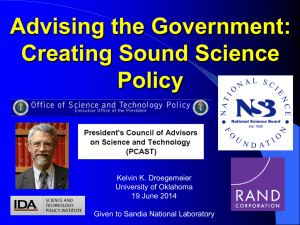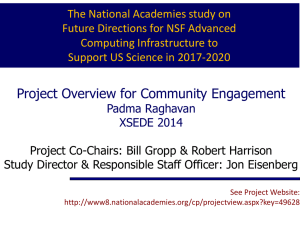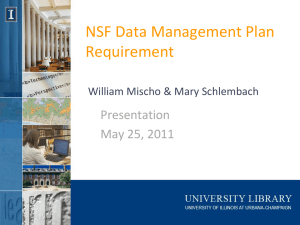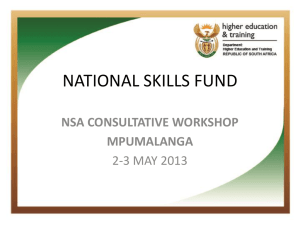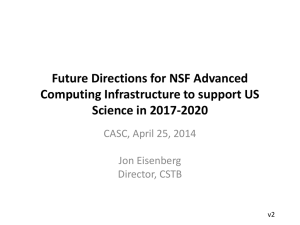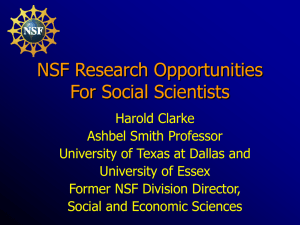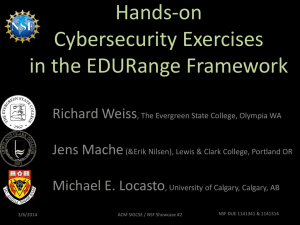Advising the Government: Creating Sound Science Policy
advertisement
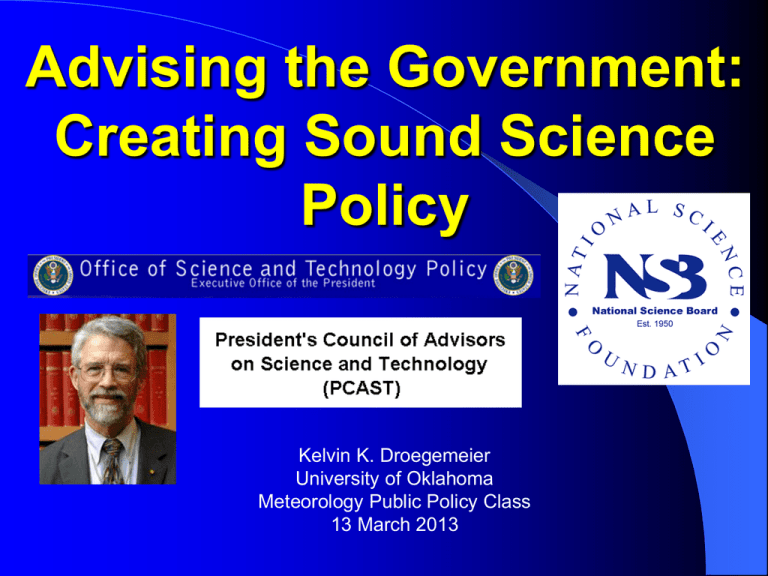
Advising the Government: Creating Sound Science Policy Kelvin K. Droegemeier University of Oklahoma Meteorology Public Policy Class 13 March 2013 The Elusive Concept of “Policy” What is it? Who/what determine it? Who enforces it? How is it changed? How do we avoid bad policy? According to Webster… Policy is… – Any plan or course of action designed to influence and determine decisions or actions – A guiding principle or procedure Some OU Examples Doctoral qualifying exam Private use of University Internet Use of cell phones Make-up exams and tardy submission of homework Sexual harassment Nepotism Ethical conduct of research Private consulting “Public” Policy Is a process that draws out the collective wisdom of a diverse group to reach a common public goal Does not involve the generation of knowledge, but the (wise) use of it National Examples Immigration Gun control Carbon Dioxide omissions Education standards Welfare Land conservation Foreign policy – assistance to other nations Rates of industrial emission of toxic materials Stem cells/cloning UAV integration into national airspace system/privacy issues Development of Science Policy Scientists discover and communicate facts and uncertainties Policy analysts consider the above in light of values held by various sectors and frame the problems as well as propose courses of action Policymakers assess the significance by making value judgments to determine how research outcomes will be applied Communicators (media, government) facilitate understanding by the public Some Challenging Policy Issues Global climate change Genetic engineering/cloning Stem cell research Hydraulic fracturing (fracking) and deep injection wells Others… An “Iron Triangle” Policy Makers/Legislators Advocates/Lobbyists Scientists An “Iron Triangle” Don’t want to make Policy Makers/Legislators decisions that upset their constituency; pass the buck to the scientist funding! Advocates/Lobbyists Scientists An “Iron Triangle” Policy Makers/Legislators Advocates/Lobbyists Get $$ to expand knowledge and help resolve policy issues (IPCC) Scientists An “Iron Triangle” Policy Makers/Legislators Looking for scientific data to support their position Advocates/Lobbyists Scientists An “Iron Triangle” Policy Makers/Legislators Looking for scientific data to support their position Looking for scientific data to support their position Advocates/Lobbyists Scientists An “Iron Triangle” Policy Makers/Legislators Looking for scientific data to support their position Looking for scientific data to support their position Provided the outcome supports their position! Advocates/Lobbyists Scientists Science Becomes the Battle Ground Legitimate debate about values and interests is being replaced by tactics of professional character assassination, spin The war zone: policy analysis versus political advocacy The War Zone Policy analysis increases the range of alternatives available to decision makers by associating scientific results with a range of choices and outcomes The War Zone Political advocacy decreases the range of alternatives, often down to a single result that supports the view of a party or legislator Example: Global Warming The IPCC does not assess scientific results in the context of policy Leads to interpretation by advocates, lobbyists, industry, interest groups The objective research outcomes fit everyone’s need but are entirely politicized So Who Advises the Government? FORMALLY Office of Science and Technology Policy (in the Office of the White House – President’s Science Advisor) (OSTP) President’s Council of Advisors on Science and Technology (PCAST) National Academies (via the National Research Council, the NAS operating arm) National Science Board (NSB) National Science and Technology Council (NSTC) Professionals (via formal Congressional hearings) Others (e.g., Council on Environmental Quality) So Who Advises the Government? INFORMALLY Lobbyists UCAR, professional societies (AMS), trade organizations (AWCIA) Political action committees Civic organizations, Chambers of Commerce Non-profits and think tanks For-profit companies Individual citizens OTSP Political appointees (reflect Admin views) Loaners from other agencies NSTC National Academies Chartered by President Lincoln Advises the nation on issues of science, technology and medicine Enlists the nation’s most eminent scientists and engineers Coordinates federal environmental efforts and works closely with agencies and other White House offices in the development of environmental policies and initiatives. Reports annually to the President on the state of the environment – oversees federal agency implementation of the environmental impact assessment process – acts as a referee when agencies disagree over the adequacy of such assessments. The National Science Board Origin of the National Science Foundation: The Manhattan Project Intensive 2-year, $2B (in 1940 dollars) effort to build a fission weapon to end World War II Involved hundreds of academic scientists and technicians – universities were raided Los Alamos was created to bring everyone together in a secure location At end of war, scientists were heroes (penicillin, radar, the bomb) Office of Scientific Research and Development (OSRD) was created to fund research projects in university and industrial laboratories – precursor to the NSF Key Individual Vannevar Bush – President Roosevelt’s science advisor Directed the OSRD Convinced President Roosevelt that the best way to continue using US researchers was to keep them on their campuses and fund them with Federal dollars This was a bold new idea – $20 M in research at universities in 1930s – $90 M by mid 1940s Manifesto that Created NSF V. Bush (1945) Available at http://www.nsf.gov The NSF Act of 1950 So-called “Organic Act” that established the NSF Signed into law by President Truman on May 10, 1950 Mission: To promote the progress of science; to advance the national health, prosperity, and welfare; to secure the national defense; and for other purposes. “The NSF Shall Consist of a National Science Board … and a Director” Unlike ALL other agencies that have science components (NASA, NOAA, DOE, DOD, EPA, USGS, etc), the NSF does not reside within a Cabinet Department – it is completely independent NSF thus is not a traditional “mission agency” though it has a clear mission! One of the best run agencies in Government Support: Total Federal Federal Basic Research Support at Institutions Research at Academic BasicAcademic Institutions $12.6B NIH 61% NSF 20% Other 19% The NSF Today Annual budget of $7B The NSF is unique – it funds all areas of science and engineering (exclusive of medicine) National Science Board Roles and Responsibilities The NSB is part of the NSF The NSB – Establishes Policies of the National Science Foundation – Oversees and guides the activities of the National Science Foundation – Serves as an independent national science policy body that provides advice to the President and the Congress on matters of national science and engineering policy National Science Board Membership 24 members with the NSF Director an ex-officio • Every 2 years, 8 people are nominated by the President, confirmed by the Senate for 6-year terms • Nomination based upon distinguished service and preeminence in research, education, or public service • Represent academia, industry, and a range of science and engineering disciplines and geographic areas Meet 5-6 times per year in person including a retreat, supplemented with teleconferences Most work done in committees National Science Board Publications and Awards Respond to Congressional Requests – Budgetary and Programmatic Expansion Initiate and Conduct Studies – Workforce – Infrastructure – Environment – International – Federal Research Priorities – Education Publish S&E Indicators Administer Honorary Awards Advising the President and Congress Responding to Congressional Inquiries Initiating its own activities The NSB is very unique and valuable as an advisory body because it – Answers to no Cabinet department – Can be fully candid and not fear political pressure Advising the President and Congress Responding to Congressional Inquiries Initiating its own activities The NSB is very unique and valuable as an advisory body because it – Answers to no Cabinet department – Can be fully candid and not fear political pressure Important Example Advising the President and Congress Responding to Congressional Inquiries Initiating its own activities The NSB is very unique and valuable as an advisory body because it – Answers to no Cabinet department – Can be fully candid and not fear political pressure Available at http://www.nsf.gov/nsb Gathering Community Input Who Protects Us From Bad Policy? Today, COGR's primary function is to provide advice and information to its membership and to make certain that federal agencies understand academic operations and the impact of proposed regulations on colleges and universities. COGR helps to develop policies and practices that fairly reflect the mutual interests and separate obligations of federal agencies and universities in research and graduate education. An independent, nonpartisan agency that works for Congress. Often called the "congressional watchdog," GAO investigates how the federal government spends taxpayer dollars. Seat of the Pants or Informed Strategy? Ways to Become Involved As individual citizens: meeting with Members of Congress (each has local offices) Serving as a AAAS Fellow in Federal agencies Serving on Agency boards and committees NOAA Science Advisory Board NSF Directorate Advisory Committees Being invited to testify at Congressional hearings Joining advocacy groups and contributing to campaigns Don’t Just Wing It!!!
